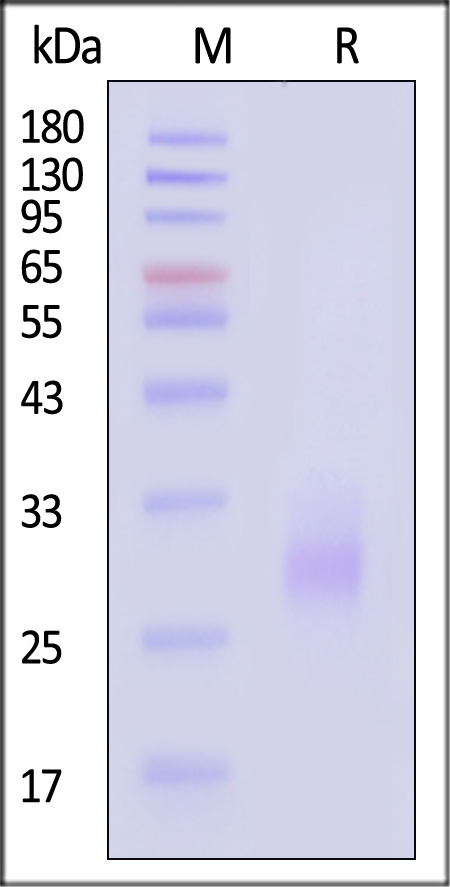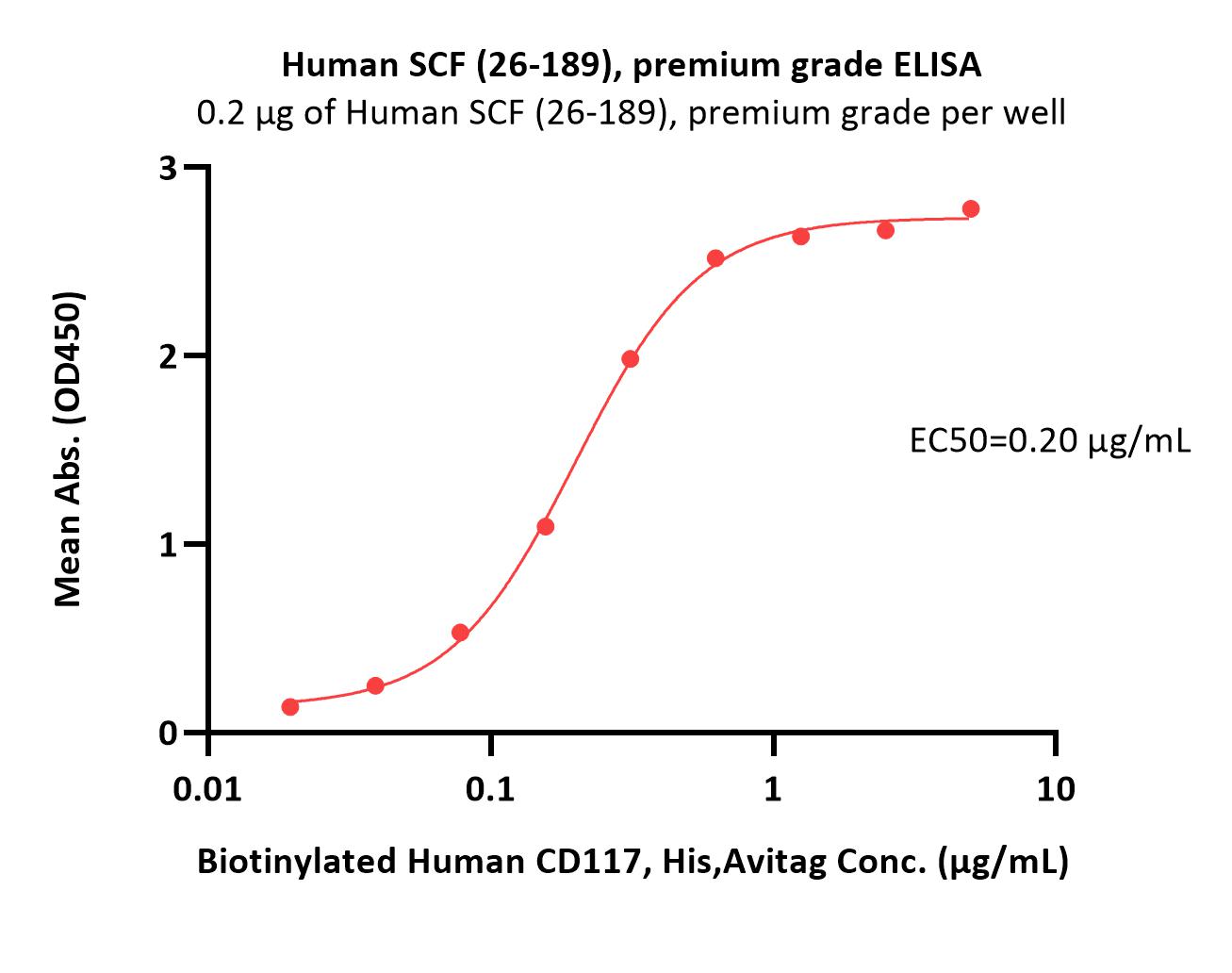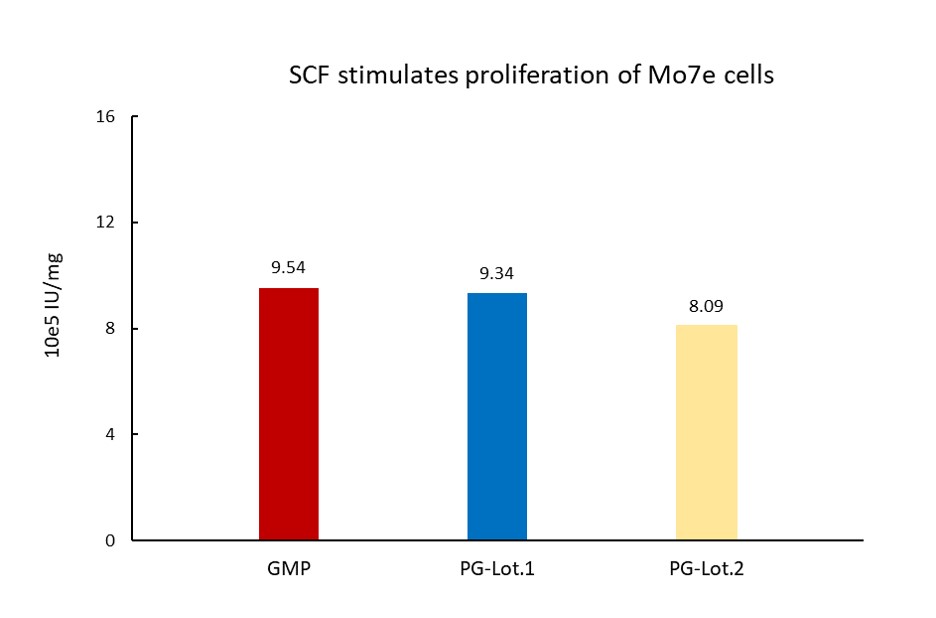分子别名(Synonym)
KITLG,FPH2,KL-1,Kitl,MGF,SCF,SF,SHEP7,KL
表达区间及表达系统(Source)
Human SCF (26-189), premium grade (SCF-H5219) is expressed from human 293 cells (HEK293). It contains AA Glu 26 - Ala 189 (Accession # P21583-1).
Predicted N-terminus: Glu 26
It is produced under our rigorous quality control system that incorporates a comprehensive set of tests including sterility and endotoxin tests. Product performance is carefully validated and tested for compatibility for cell culture use or any other applications in the early preclinical stage.
GMP-SCFH25 is the GMP version of this SCF-H5219. These two proteins display indistinguishable performance profiles, thereby ensuring a seamless transition for end users from early preclinical stag to later clinical phases.
Request for sequence
蛋白结构(Molecular Characterization)

This protein carries no "tag".
The protein has a calculated MW of 18.5 kDa. The protein migrates as 30 kDa±3 kDa when calibrated against Star Ribbon Pre-stained Protein Marker under reducing (R) condition (SDS-PAGE) due to glycosylation.
内毒素(Endotoxin)
Less than 0.01 EU per μg by the LAL method.
宿主蛋白残留(Host Cell Protein)
<0.5 ng/µg of protein tested by ELISA.
宿主核酸残留(Host Cell DNA)
<0.02 ng/μg of protein tested by qPCR.
无菌(Sterility)
Negative
支原体(Mycoplasma)
Negative.
纯度(Purity)
>95% as determined by SDS-PAGE.
>95% as determined by SEC-MALS.
制剂(Formulation)
Lyophilized from 0.22 μm filtered solution in PBS, pH7.4 with trehalose as protectant.
Contact us for customized product form or formulation.
重构方法(Reconstitution)
Please see Certificate of Analysis for specific instructions.
For best performance, we strongly recommend you to follow the reconstitution protocol provided in the CoA.
存储(Storage)
For long term storage, the product should be stored at lyophilized state at -20°C or lower.
Please avoid repeated freeze-thaw cycles.
This product is stable after storage at:
- -20°C to -70°C for 12 months in lyophilized state;
- -70°C for 3 months under sterile conditions after reconstitution.
电泳(SDS-PAGE)

Human SCF (26-189), premium grade on SDS-PAGE under reducing (R) condition. The gel was stained with Coomassie Blue. The purity of the protein is greater than 95% (With Star Ribbon Pre-stained Protein Marker).
SEC-MALS

The purity of Human SCF (26-189), premium grade (Cat. No. SCF-H5219) is more than 95% and the molecular weight of this protein is around 46-56 kDa verified by SEC-MALS.
Report
活性(Bioactivity)-CELL BASE

Human SCF (26-189), premium grade (Cat. No. SCF-H5219) stimulates proliferation of Mo7e cells. The specific activity of Human SCF Protein, premium grade is > 5.00×10^5 IU/mg, which is calibrated against human SCF WHO International Standard (NIBSC code: 91/682) (QC tested).
Protocol
活性(Bioactivity)-ELISA

Immobilized Human SCF (26-189), premium grade (Cat. No. SCF-H5219) at 2 μg/mL (100 μL/well) can bind Biotinylated Human CD117, His,Avitag (Cat. No. CD7-H82E6) with a linear range of 0.02-0.3 μg/mL (QC tested).
Protocol
稳定性(Stability)

The Cell based assay shows that Human SCF (26-189), premium grade (Cat. No. SCF-H5219) is stable at 37℃ for 48 hours.

The Cell based assay shows that Human SCF (26-189), premium grade (Cat. No. SCF-H5219) is stable after freezing and thawing 3 times.

The Cell based assay shows batch-to-batch consistency between Acro's GMP and PG SCF.
背景(Background)
Stem Cell Factor is also known as SCF, kit-ligand, KL, steel factor, KITLG, FPH2, KL-1, Kitl, MGF, SCF, SF, or SHEP7, and is a cytokine that binds to the c-Kit receptor (CD117). SCF can exist both as a transmembrane protein and a soluble protein. This cytokine plays an important role in hematopoiesis (formation of blood cells), spermatogenesis, and melanogenesis. The soluble and transmembrane forms of the protein are formed by alternative splicing of the same R transcript.Soluble and transmembrane SCF is produced by fibroblasts and endothelial cells. Soluble SCF has a molecular weight of 18,5 KDa and forms a dimer. SCF plays an important role in the hematopoiesis during embryonic development. Sites where hematopoiesis takes place, such as the fetal liver and bone marrow, all express SCF. During development, the presence of the SCF also plays an important role in the localization of melanocytes, cells that produce melanin and control pigmentation. SCF plays a role in the regulation of HSCs in the stem cell niche in the bone marrow. SCF may be used along with other cytokines to culture HSCs and hematopoietic progenitors. The expansion of these cells ex-vivo (outside the body) would allow advances in bone-marrow transplantation, in which HSCs are transferred to a patient to re-establish blood formation.























































 膜杰作
膜杰作 Star Staining
Star Staining












